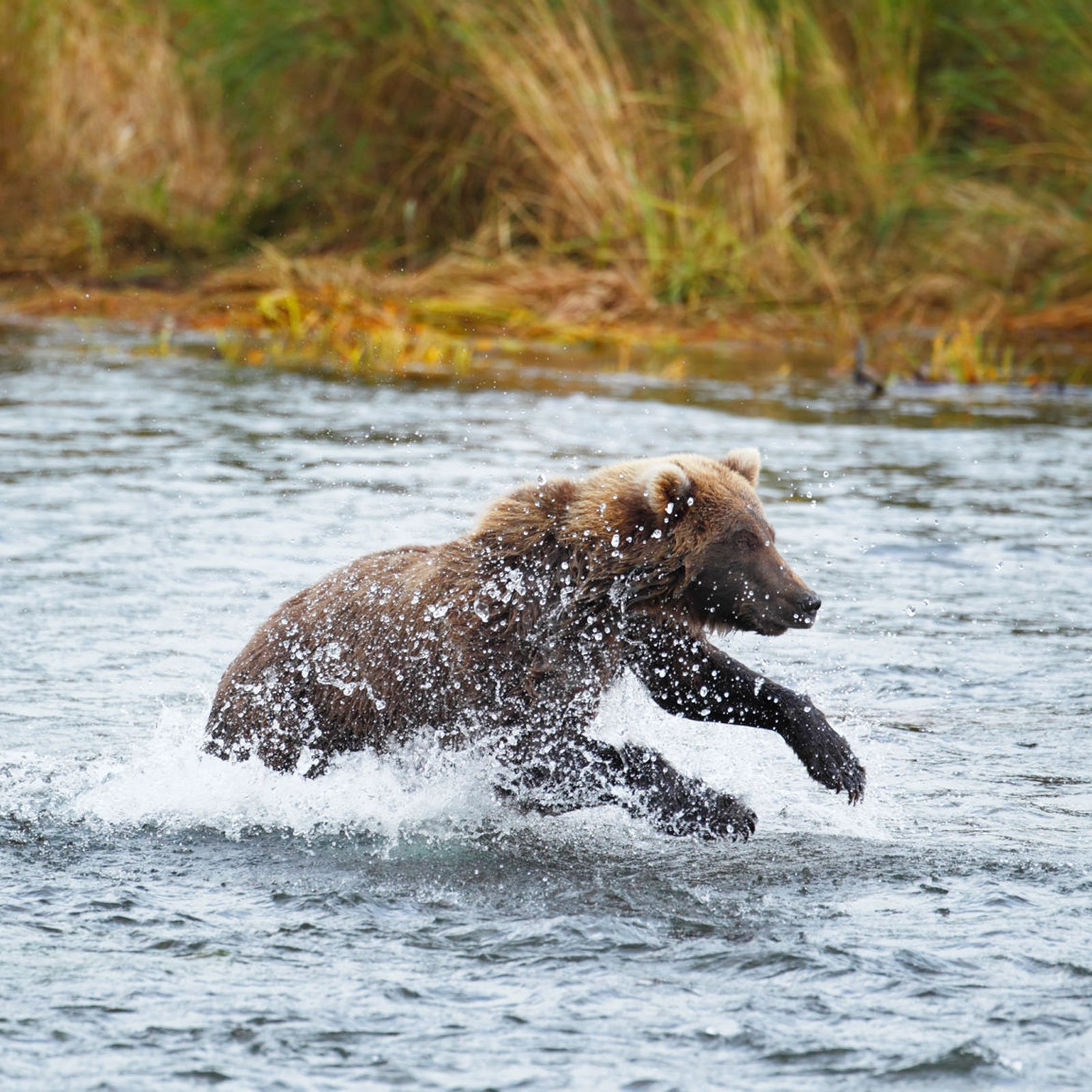Imagine: You’re on a backpacking trip in Alaska, bushwhacking along an overgrown trail, when—hey now!—you’re up close and personal with a 400-pound griz. You, A) turn screaming and bolt past your buddies; B) unshoulder your .30/06 and level it between said griz’s eyes; or C) quick-draw your hip-holstered canister of pepper spray.
If you picked A, you just made the bear’s dinner menu. If you’re leaning toward B, you’re probably a bear-country veteran with a lot of faith in, and probably decent skill with, firearms. If you went with C you may be among the converted who believe a growing body of research suggesting that non-lethal deterrents aren’t just a feel-good alternative for animal-loving liberals, but a field-tested defense strategy backed up by hard data. Such claims aren’t without merit, or controversy. But while everyone from veteran guides to Second Amendment zealots has sounded off against the superiority of spray over guns, a survey of recent studies only reinforces the arguments in favor of pepper spray.
Bear Spray vs. Guns: What New Science Says
In March 2012, the ��published Tom Smith and Stephen Herrero’s “.” The paper’s prosaic title didn’t prevent it from grabbing headlines around the country. For the first time, bear researchers had provided compelling statistical evidence that firearms were less effective in protecting individuals against bear attacks than many folks previously believed, including the researchers themselves. Among their conclusions were 1) that “firearm bearers suffered the same injury rates in close encounters with bears whether they used their firearms or not,” and 2) that “bear spray [has] a better success rate under a variety of situations … than firearms.”
The report is already being widely cited by both wilderness-area managers tasked with keeping people who travel in bear country safe and wildlife biologists and others looking to reduce unnecessary bear killings, as well as injuries, or worse, to humans. The analysis drew information from “readily accessible state and federal records, newspaper accounts, books, and anecdotal information that spanned the years 1883 to 2009.” The data set included 444 people, 357 bears (black, brown, and polar), and a total of 269 close encounters. Bear-inflicted injuries occurred in 151 of the incidents, including 17 fatalities, while aggressive bears were repelled (or killed) 84 percent of the time with handguns, and 76 percent of the time with long guns.
“When I was hired by the government in Alaska they asked me to give some advice about how to be safe in bear country,” says Tom Smith, an associate professor of at Brigham Young University. “But all the information I could find was either based on no data at all, or just misguided impressions.”
Why Spray May Be More Effective
This past March wasn’t��the first time Smith set out to see how hard numbers stacked up against the differing opinions on the often heated guns vs. pepper spray debate. In 2008, he coauthored a similar study looking specifically at the effectiveness of pepper spray in bear encounters in Alaska. The researchers gathered reports from 1985 to 2006 (spray wasn’t used before the mid-’80s), and reviewed 83 close bear encounters involving 156 people. The conclusions were startling: In all of the incidents involving spray, there were only three injuries, and none of them fatal—a 98-percent success rate.
There is wiggle room in the numbers, of course. No bear encounter is identical, and the number of variables, from type of terrain to equipment malfunction, vary significantly from incident to incident. Nonetheless, the evidence remains persuasive. When I called Stephen Herrero, Smith’s co-author on both the 2008 and 2012 studies, and one of the leading bear experts in North America, to ask if the conclusions from the 2008 Alaskan study could be applied to bears in the Lower 48, he said, “The answer is mostly ‘yes.’ The little qualifier is because terrain factors in bear encounters make a big difference. There’s [more] dense bush in Alaska [than in the Lower 48], and that’s where some of the worst bear attacks seem to concentrate.”
In all of the incidents involving spray, there were only three injuries, and none of them fatal—a 98-percent success rate.
The studies have also come under further scrutiny in light of the cluster of attacks last summer. After an unusual spate of deaths in and around Yellowstone, there was speculation in the media that that, due to declining food sources, bears were altering their behavior and increasingly looking at humans as dinner. But Herrero, who also authored a 2011 report that looked at more than 100 years worth of black bear-related human fatalities nationwide, suggests that predatory bears aren’t new. Rather, the rising number of encounters follows a “consistently linear correlation with population growth,” he says, adding, “but that’s correlation, not causation. In other words, one of the main reasons we’re seeing more predatory encounters is that they are simply more people tromping around in bear country. There very well may be other reasons, too. As Herraro stressed to me, the studies aren’t conclusive, and more research is necessary.
One aspect of the debate that is pretty clear is that the growing body of research provided by Smith, Herrero, and other bear scientists doesn’t seem to be having an immediate impact on policymakers. In February 2010, a controversial federal law went into effect that allowed visitors to bring firearms into U.S. national parks. That legislation was met with an ample uproar—guns in our national parks? Really?—though the concern appears overblown at this point. “One of our biggest fears was that, with the new law, we’d have people recklessly shooting bears resulting in injured animals running around, but that just hasn’t happened,” says John Waller, a wildlife biologist at in Montana. Still, Waller believes that with time, spray will replace firearms as the deterrent of choice. “There’s a strong gun culture in the West, and they’re something that people are familiar with and comfortable with and have confidence in. Spray is a new thing that doesn’t look very impressive, and it may take some time for people to realize just how well it works. Ultimately, I think it will be a no-brainer.”
Not everyone shares such opinions, however. For every wildlife biologist that champions the efficacy of pepper spray, there’s an outdoorsmen who remains a nonbeliever. ��“I’ve read about bear spray. I know people say it’s effective. But personally, I’m much more comfortable with a firearm,” says Keith Atcheson, a hunting outfitter based in Butte, Montana. “We don’t encourage use of bear spray because we don’t feel you need that and a firearm. The thing is though, people should have something on them. If you turn and run, you’re going to get chased, and if you get caught, it’s not going to be pretty.”
A Bear Attack in Action
It wasn’t pretty when just such an incident occurred in Alaska last July. A group of teenagers with the (NOLS) were hiking along a creek through deep brush in Alaska’s Talkeetna Mountains, near Denali. It was raining heavily, and the seven-member “student expedition,” in which a group spends about 24 hours camping in the bush without instructors, were moving single file up the drainage. The first student in line came upon what he thought were “hay bales” in the foliage. It was a grizzly sow and her cub.
In other words, one of the main reasons we’re seeing more predatory encounters is that they are simply more people tromping around in bear country.
The hiker turned and screamed and the group started running. The bear was on them instantly. Three members of the group were carrying bear spray, but couldn’t get to it in time. “When they encountered the bear, it was at surprisingly close range, and they didn’t react they way they had been trained to,” says NOLS spokesman Bruce Palmer. Had they followed their training, they would have grouped up, stood their ground, made noise, and, ideally, deployed the spray. But instinct and fear took over. Two of the boys wound up in critical condition, with lacerations and punctures to their head, neck, and chest. Two others were injured less severely. Ultimately, the survival of the injured students was credited to some swift and smart triage in the field by their uninjured tripmates. If the students failed one test, they aced the next one.
“We’re making some changes to enhance our bear practices,” says Palmer. “More bear spray, one per person, especially in areas where we know there’s higher bear potential, like Talkeetna. We’ll have holsters, and the spray will be on the person, not in a pack. We’re also working toward what we’re calling the ‘one-hand draw,’ so you can get it out there fast.”
The bottom line is that reacting the way you’ve been trained to in a life-threatening situation is an inherently difficult thing to do. “They responded the way a lot of us might when faced with something that terrifying,” continues Palmer. “It’s nice to say, get into a group and get your bear spray out. A lot of our education has been telling people what they should do, but we’re going to move toward more practicing, doing drills, so they can respond better.”
NOLS, it’s worth noting, observes a strict no-firearms policy on its trips. Though it’s hard to imagine that might make any difference in circumstances like the ones the students encountered last July. Not only would it require the wherewithal to draw and fire a gun, you’d need expert skills to hit a charging bear in such a way that it would stop the charge. Examples abound of incidents in which bears get shot during an attack—and still keep coming. In one particularly unfortunate case in Montana last September, a man accidentally shot and killed his hunting partner while trying to defend the partner who was being mauled by a grizzly.
“Hitting a target the size of a baseball, especially when the target’s coming at you at 30 miles an hour and swaying side to side, isn’t easy,” says Stephen Herrero, who is among those who have actually accomplished such a feat. “All of our research continues to show that the basics of safety aren’t about how you well you deploy a firearm or how effectively you get to your bear spray, but how you avoid getting in those situations in the first place.”


